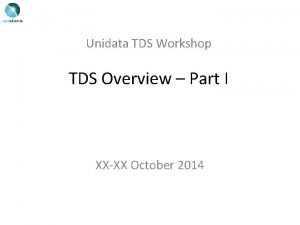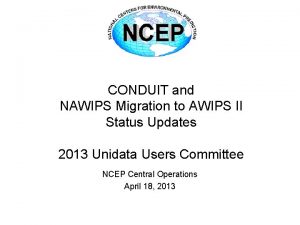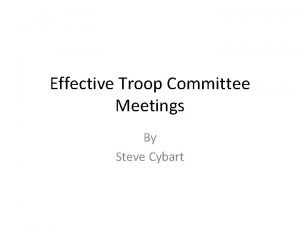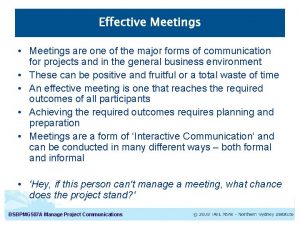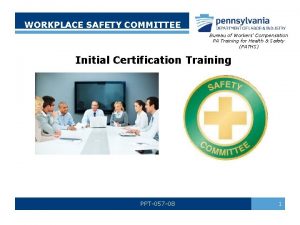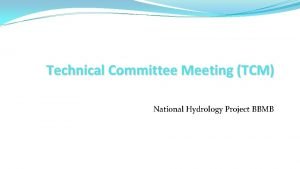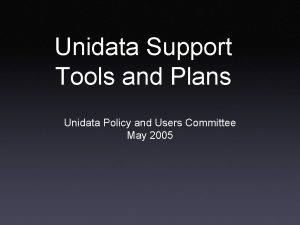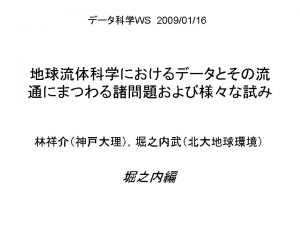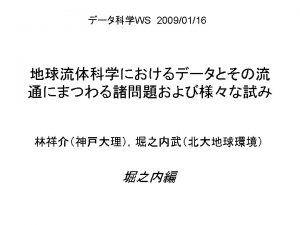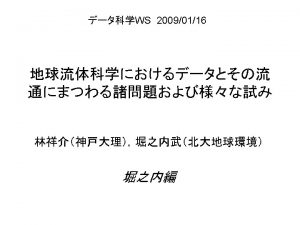Strategic Planning Unidata Policy Committee Meeting 24 May







- Slides: 7

Strategic Planning Unidata Policy Committee Meeting 24 May 2011

Reasons this is important • Need an updated strategic plan to inform our next core-funding proposal, which will be submitted in early 2013. • To develop a shared vision for the program. • Bring staff together and connect their day-today work with higher level goals. • It is a useful management tool, helping with setting priorities, and resource planning and allocation.

Actionable Strategic Plan • An Actionable Plan should: – – – be primarily focused on the next 3 -5 years, be relatively short (~3 -4 pages) and easy to build and change, be an effective management tool for allocating resources, connects the day-to-day work to the higher-level goals, and makes the PURPOSE of the organization clear. • Purpose: – Core Values: What would you retain even in the face of huge impacts (what can your staff always count on)? – Product/Services and Customers: What are you offering, who pays for them, who uses them, and what does the user experience? – Value Proposition: How would you differentiate your products/services from other competitors (pick a primary approach that would appeal to your customers and reflect resources)? • Cheapest Price (e. g. , Walmart, Mc. Donalds). • Cutting Edge Products (e. g. , Intel, Apple). • Highest Customer Service (e. g. , Ritz Carleton, Burger King).

Build from the Bottom Up Brain Storming, No Formal Writing Yet! • Answer the following questions (i. e. , don’t start writing mission statements): 1. What are our core values? 2. Who are our customers, what do the experience, and how does that contribute to outcomes? 3. Who pays or raises money to produce these experiences? 4. How are our user experiences different from other competitors? • Key Words. Underline the key words or phrases in the answers that are critical to success (values, customers, experience, outcomes, etc): – These words must be reflected in all vision, mission, goal, and objective statements – They connect the day-to-day work to the vision, mission, etc.

Begin to Create the Plan • Based on the Answers and Key Words: write a preliminary vision (5 -10 years) and mission (3 -5 years) statement 1. Don’t include anything you can’t measure or control. 2. Format: “Achieve a goal BY taking a clearly defined action BY a specific date or period. ” • Goals/Objectives. Write G/Os required to meet the Vision/Mission statement -- they must be in the Actionable Format and use the same key words. • Accountability. The vision, mission, goal, and objective statements are assigned to an individual or group -- a real management tool! • The Plan. Add an introduction to all of this – that is your plan! • Metrics and Test. The metrics are built into the plan’s statements (not separate). Best test of the plan is to walk a user through the entire plan and examine whether you really achieve the desired outcomes (i. e. , break the plan).

Next Steps Discussed at Staff Meeting • Process for developing the plan and identifying the best path forward. – – – Brainstorming Getting additional input Drafting the plan Finalization Guidelines and format Time-table • Agreement on above as well as agreement that we are all peers in this exercise and share the responsibility for developing a plan and a shared vision for the program. • Will be holding a mini-retreat on 8 June to begin the exercise. • A draft will be prepared for feedback and additional input from both governing committees before the Fall committee meetings.

Committee Input • Process, format, etc. • Focus: Evolving community needs, science and education drivers, technology evolution • Responsibilities, obligations, and growing expectations • Opportunities, challenges, and threats • Core values and guiding principles
